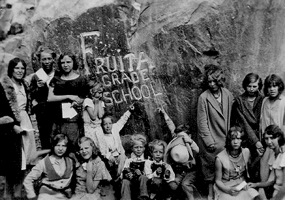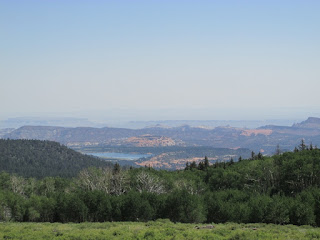We departed Thousand Lakes RV Resort and headed east on UT 24,
back through Torrey Utah and a portion of Capitol Reef National Park.
On part of the drive, one of the caravaneers, keyed
their mike on our FM radios and said “look over at 10 o’clock, it looks like
the Badlands.” I have never been to the Badlands, but if that is what they look
like, count me in! Adding it to the bucket list!
As we moved further east on UT 24 past Capitol Reef National
Park, we passed through Caineville UT. I would not call it a big town, I might
not even call it a town! But it is sparsely populated ranching and farming
community, with several homes, a café, RV site and a Roadway Inn! History tells
us that the town was originally settled along the fertile banks of the Fremont
River in 1882. According to one legend, the Mormon Church sent the Ney and Behunin
families to settle the untamed area; Ney left after one night but Behunin and
his nine family members stayed and built the first cabin in the area. Other
sources say a young Walter Hanks led the way on foot, followed by Behunin and two
others who together accomplished the difficult task of taking a wagon through
the rugged Capitol Reef gorge.
By the spring of 1883, several families had
joined the Behunins, and Caineville continued to grow into an agricultural
community. During the winter of 1892-‘93 a diphtheria outbreak struck the
community, claiming many lives. Over the years the town was also plagued by
several floods. After a particularly devastating flood in 1909 many farmers and
ranchers abandoned the town. Behunin’s cabin still stands, sort of, and can be
seen just off Highway 24
In the middle of these rock formations is an old cement
truck, looks like at one time, it was used to point the way to the café. It
does look like it belongs among the rock formations, because they look more
like piles of sand or dirt, than rocks. But I can guarantee you they are hard
as rock!
We passed by Factory Butte, to the north of UT 24. Factory
Butte is the most recognizable feature of a large area of stark, barren land
either side of the Fremont River known as the Upper Blue Hills. The topography
is characterized by the grey color, completely devoid of vegetation. If you did
not see the sign, you would not know that it was anything special!
There was a “Giles Townsite” sign on UT 24, between
Caineville and Hanksville. The historic ghost town of Giles sits precariously in the
middle of the breathtakingly barren and stark Blue Valley which takes its name
from the surrounding blue clay. The first settler in Blue Valley was Hyrum
Burgess and his family who settled on the north side of the river in 1883. Hite
Burgess is credited with surveying the first dam and three-mile irrigation canal.
The dam was made of rock and brush. After a short time a flash flood washed the
dam away. In June of 1895, a town site south of the Fremont River was laid out
and dedicated with fifty original parcels of land, four short streets, and two
long streets. A bridge was used to cross the river from the main county road into
the town of Giles. At this time, the town name of Giles was chosen in honor of
Henry Giles, the first Latter Day Saint Bishop. Another dam was built high
enough to get the water into the ditches and, due to this success other
settlers came to live in Blue Valley Giles in March of 1887. The ninety plus
families of Giles in Blue Valley began to desert and move out after devastating
and repeated flooding that occurred in 1909 and 1910. Jonathan Hunt was one of
the last people to stay in Giles. Mr. Hunt died in Giles in 1922.
We drove along the Fremont River, which flows from the Wasatch
Plateau through Capitol Reef National Park to the Muddy Creek near Hanksville.
We found these interesting concrete channels in the river hear UT 24.
In Hanksville, UT 24 turns north toward I-70. Hanksville is a
small town of less than 400 people. It is rich in folklore and history, thrives
on tourism for travelers seeking a central location to explore Capitol Reef
National Park, Goblin Valley State Park, the San Rafael Swell and Robber’s
Roost. Hanksville was first settled in 1882 and called “Grave’s Valley” after a
member of the Powell expeditions. The settlement, which lies at an elevation of
4300 feet, was renamed Hanksville in 1885 for Mormon pioneer leader Ebenezer
Hanks. Agriculture and mining were the primary roles of the community but
outlaws such as Butch Cassidy and his Wild Bunch often came to Hanksville for
supplies while hiding out in the nearby canyons. Hanksville was also a main
supplier for uranium prospectors in the 1940s and 50s. Hanksville’s uranium and
gold booms have long since ended, but the area is still rich in dinosaur
fossils which are frequently uncovered at the Hanksville-Burpee Quarry.
The Hallow Market is located at the intersection of UT 24
& UT 95. Just as its name sounds, the convenience store is located in a
hallowed out rock formation. It took the owners 4 months to excavate. We made a
rest stop adjacent to this gas and grocery store. One of our caravaneers had a
fuel line leak. The tail-enders (the couple that brings up the rear of our
convoy of RV’s) stayed behind with them, while the rest forged ahead. The
Tail-enders went in search of a mechanic. Two miles down the road, they found
one. He came to the location, figured out what he needed, went back to his shop
and got the tools and parts needed. Came back to the RV and repaired it. The
best news, was this small town mechanic, that saved the day … charged less than
$100 for the entire repair! A mechanic
contracted by anyone of our extended warranty companies would have charged much
more than that!
We passed by Goblin Valley State Park. The name makes me
want to turn in and check it out! Its eminent feature is its thousands of
hoodoos and hoodoo rocks, referred to locally as "goblins" which are
formations of mushroom-shaped rock pinnacles. The distinct shapes of these
rocks come from an erosion-resistant layer of rock atop softer sandstone. Along
with Bryce Canyon National Park, Goblin Valley State Park is one location with
some of the highest occurrences of hoodoos in the world.
We turned onto Interstate 70 East and headed to UT-191,
where we exited the Interstate and headed south on 191.
 We passed by the Moab Regional Airport, and it made us miss
home. We saw a sky diver descending from Skydive Moab and it reminded us that we can see sky
divers every day from Majestic Oaks RV Resort.
We passed by the Moab Regional Airport, and it made us miss
home. We saw a sky diver descending from Skydive Moab and it reminded us that we can see sky
divers every day from Majestic Oaks RV Resort.
We arrived at our home for the next four nights, Archview RVResort. Over the horizon, we could see the first glimpses of Arches National
Park.
It amazes me, every time we drive from place to place, how
the rock formations change. Not just minor changes, but complete changes in the
structure, color and overall views. The whole trip is full of unique
formations, thus pictures!
I can't wait to see what Moab and Arches National Park has in store for us, as our Adventure Continues with Yankee RV Tours!










































































